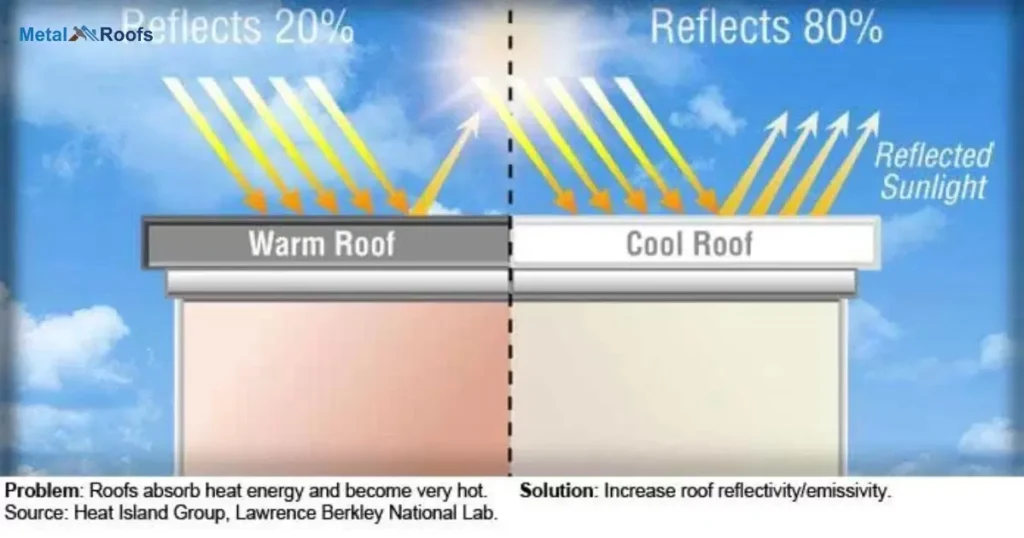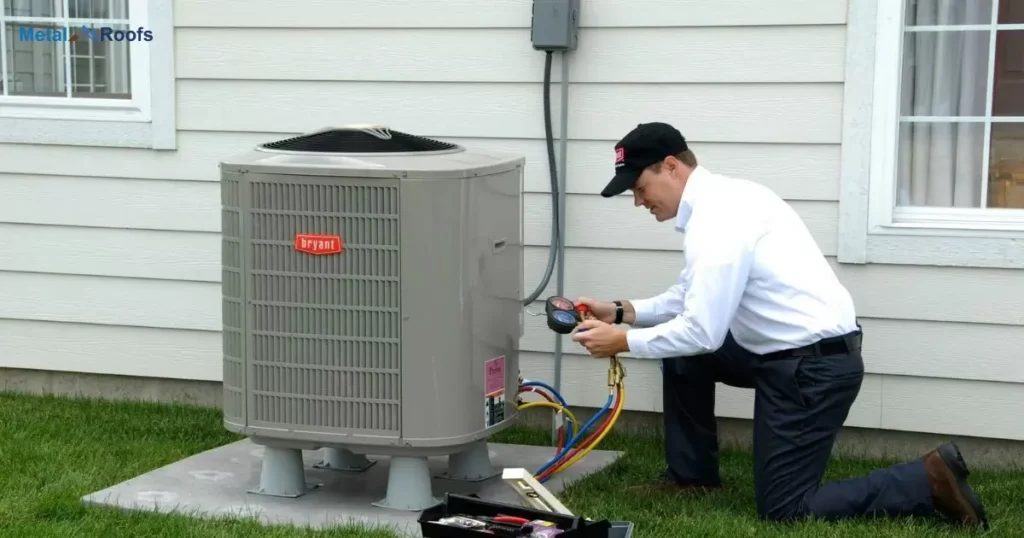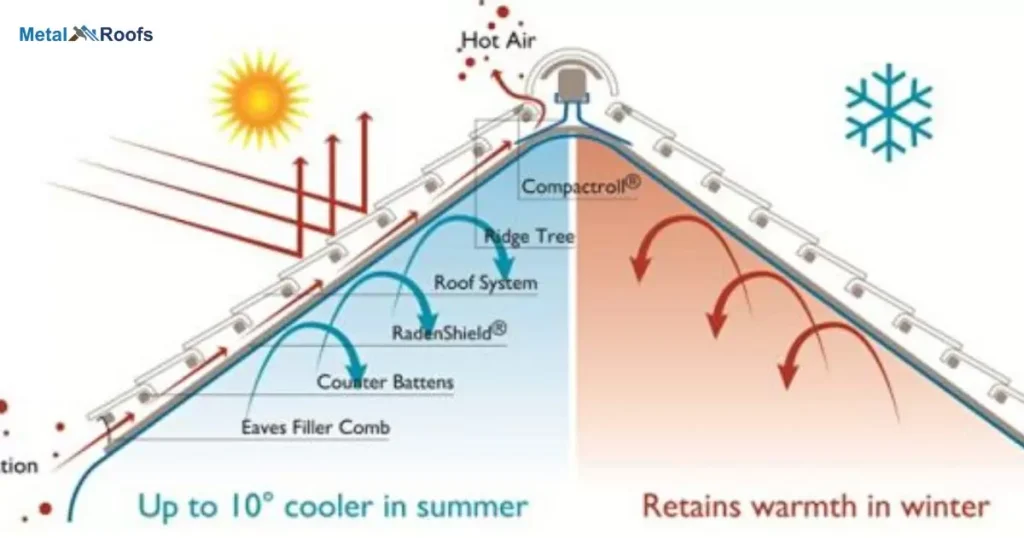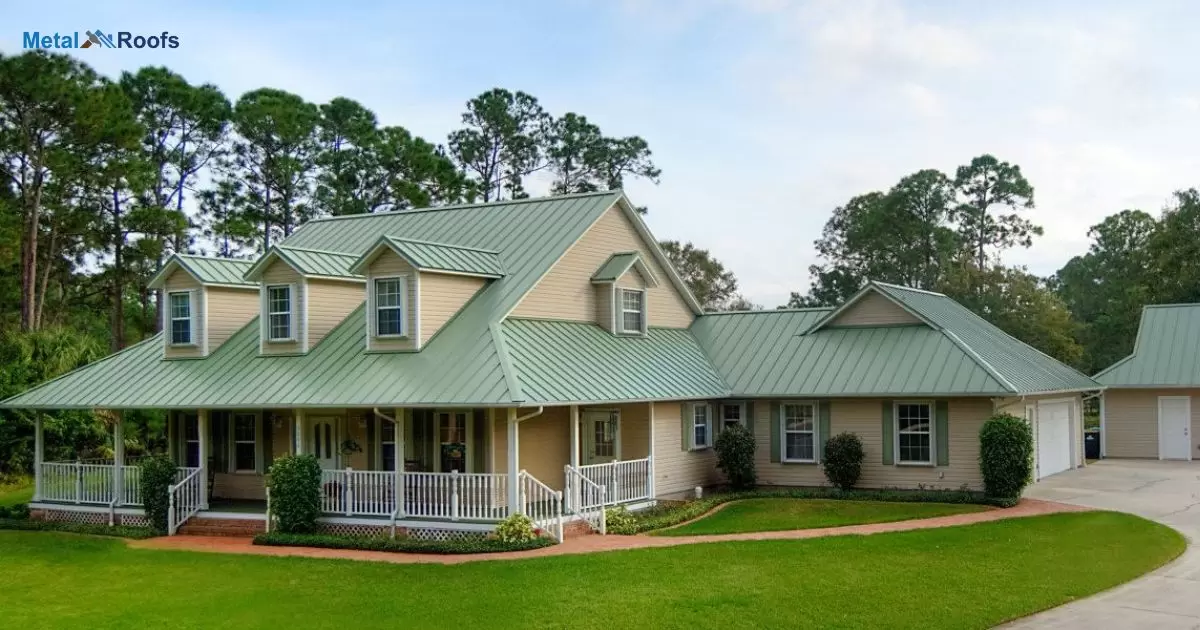Metal roofs reflect sun’s heat rays. They don’t absorb much solar energy. This keeps attics cooler in summer. Cooler attics mean lower AC costs. Metal roofs are energy-efficient. They can last for decades too. Installing them is an investment. But you save money long-term.
Beat the heat, save on AC bills. Do metal roofs keep house cooler? Yes! Metal reflects sun’s scorching rays. It doesn’t absorb heat like asphalt. Cool attics mean lower energy costs. Stay comfy without burning cash. Metal roofing is a wise choice. Upgrade now for long-term savings.
Metal roofs beat summer’s scorchers by reflecting solar radiation away, unlike asphalt shingles which absorb heat. This helps keep interiors cooler naturally, potentially resulting in lower energy bills. In Florida, choosing a metal roof lower your insurance in florida.
Key Takeaways
- Metal roofs reflect a significant amount of the sun’s rays.
- They efficiently radiate absorbed heat, cooling down quickly.
- Designed to allow air circulation, reducing heat buildup.
- Special coatings enhance reflective and emissive properties.
How Long Do Metal Roofs Keep House Cooler?
Metal roofs keep houses cooler for many years. Their reflective properties last a long time. Metal roofs also cool down quickly after sunset. This helps reduce the heat inside the house. Proper ventilation enhances this effect.
Cool roof coatings improve reflectivity. These coatings also last for years. Insulation paired with metal roofs boosts cooling. Reduced cooling costs make metal roofs a smart investment. They are durable and effective over time.
Do Metal Roofs Keep House Cooler In The Summertime?
Metal roofs help keep houses cooler in the summertime. They reflect much of the sun’s rays. This reduces the heat absorbed by the roof. They also release heat quickly once the sun goes down. This means less heat stays trapped in your home.
Metal roofs often have built-in ventilation. This allows air to flow and cuts down heat buildup. Special coatings can make them even more effective. These roofs stay reflective over time. This helps maintain cooler temperatures inside. Plus, you might save on energy bills with less need for air conditioning.
How To Keep Metal Cool In The Sun?

To keep metal cool in the sun, start by using reflective paint. Light colors work best. They reflect sunlight away. Another option is to install shade over the metal. A simple cover can make a big difference. Trees or awnings work well.
Ventilation also helps. Allow air to flow around the metal. This stops heat from building up. Use fans if needed. You can also use insulating materials. These help block the heat. Together, these methods can keep metal cool even on hot days.
Summer Cooling Effect
Metal roofs provide a significant cooling effect in summer. They reflect sunlight, reducing heat absorption. With ventilation, they prevent heat buildup. Special coatings enhance their cooling properties, saving energy and keeping homes comfortable during hot weather.
Metal Roof Cooling Properties
Metal roofs reflect sunlight, keeping homes cooler during hot weather. They efficiently radiate absorbed heat, cooling down rapidly at night. Proper ventilation minimizes heat buildup, while special coatings enhance cooling properties.
Summer Cooling With Metal Roofs
Metal roofs reflect sunlight, keeping homes cooler. They efficiently radiate heat, cooling quickly at night. With proper ventilation, they minimize heat buildup. Special coatings further enhance cooling effects. Overall, metal roofs offer effective summer cooling.
Metal Roof Cooling Efficiency
Under “Summer Cooling Effect”, metal roofs shine. They reflect sunlight, reducing indoor temperatures. Efficient heat radiation cools roofs swiftly. Enhanced by ventilation and special coatings, they offer significant energy savings.
How Metal Roofs Affect House Temperature?
Metal roofs help keep houses cooler. They reflect most of the sun’s rays. This stops the roof from absorbing too much heat. Metal roofs also cool down fast after the sun sets. They do not hold onto heat like other materials.
Many metal roofs have gaps for air flow. This helps to reduce heat buildup. Some have special coatings that boost their cooling effects. These roofs can work well with insulation to block heat. They help save on cooling costs over time.
Cooler Indoor Temperatures During The Summer

Metal roofs can help keep your home cool in the summer. They reflect much of the sun’s rays. This means less heat gets inside. The roof also cools quickly at night. Good ventilation in the roof design helps air circulate. This reduces heat buildup.
Special coatings on metal roofs enhance their cooling effect. These roofs work well with insulation. Together, they keep the house cooler. Metal roofs last a long time and stay effective. They can lower your cooling costs. This makes them a smart choice for hot climates.
Metal Roofs Keep Your House Cooler
Metal roofs reflect sunlight, keeping your house cooler. They don’t absorb as much heat as other materials. This reflective quality helps maintain a comfortable temperature inside. Plus, metal roofs radiate absorbed heat efficiently.
They cool down quickly after the sun sets. Ventilation gaps in metal roofs allow air to circulate, further reducing heat buildup. With special coatings, metal roofs enhance their cooling properties. Overall, metal roofs save energy by reducing cooling costs over time.
Metal Roofs In Hot Weather
Metal roofs reflect sunlight, keeping homes cooler. They efficiently radiate heat, cooling quickly at night. With proper ventilation, they minimize heat buildup. Special coatings further enhance cooling effects. Overall, metal roofs offer energy savings in hot weather.
Keeping Your Home Cooler
Metal roofs in hot weather contribute significantly to keeping your home cooler. They reflect sunlight, reducing heat absorption. Efficient heat radiation ensures quick cooling at night. With proper ventilation, they minimize heat buildup, offering a comfortable environment indoors.
Reducing Energy Consumption
Metal roofs contribute to reducing energy consumption. Their reflective properties keep homes cooler naturally. This reduces the need for air conditioning. As a result, homeowners save on energy bills.
Lowering Utility Bills
Metal roofs in hot weather lead to lower utility bills. They reflect sunlight, reducing the need for cooling. Efficient heat radiation keeps homes comfortable. With reduced energy consumption, costs decrease.
Metal Roofs And Energy Efficiency

Metal roofs are efficient because they reflect sunlight, which keeps homes cooler and reduces the need for air conditioning, saving energy. These roofs also radiate heat efficiently, cooling down rapidly, and they feature ventilation gaps that facilitate airflow, further enhancing their cooling capabilities.
Special coatings can be applied to metal roofs to improve their cooling properties. Overall, metal roofs are not only durable but also cost-effective in the long run due to their energy-saving benefits.
Frequently Asked Questions
Is A Metal Roof Better For Heat?
Metal roofs reflect sunlight, efficiently radiating absorbed heat to keep houses cooler and save energy.
How To Cool A House With A Metal Roof?
To cool a house with a metal roof, choose light colors, apply cool coatings, ensure ventilation, and use insulation to minimize heat transfer, ultimately saving on cooling costs.
What Is The Best Roof To Keep Your House Cool?
Metal roofs are the best option for keeping your house cool, reflecting sunlight and emitting absorbed heat efficiently.
Conclusion
Metal roofs offer a compelling solution for maintaining a cooler home environment. With their high reflectivity and efficient heat emission, they effectively mitigate heat absorption. The ventilation design prevents heat buildup, further enhancing their cooling effect.
The application of cool roof coatings enhances the reflective and emissive properties of metal roofs. This not only helps in keeping the house cooler but also contributes to long-term energy savings. Overall, opting for a metal roof can provide both immediate and lasting benefits for homeowners seeking a cooler living space.











